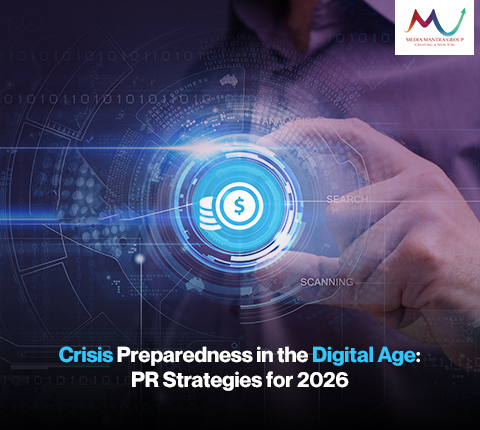6
NOV 2025
Crises no longer arrive as headlines; they begin as notifications. One viral post, one leaked chat, one customer review and suddenly, brands are not managing communications, they’re managing survival. The speed of digital scrutiny means crisis preparedness strategies are no longer a line in a corporate manual; they are a living discipline that defines business resilience.
In 2026, the difference between a company that survives a reputational storm and one that collapses overnight will come down to readiness. How well it has anticipated, rehearsed, and humanised its response. From financial institutions in Mumbai to consumer tech firms in Bangalore, crisis preparedness strategies have moved from the boardroom sidelines to the very centre of corporate governance.
Rethinking Crisis for a Hyper-Connected Era
The digital ecosystem has fundamentally changed how crises form and unfold. Traditional response timelines of 24 hours have shrunk to 24 minutes. In such an environment, crisis preparedness strategies must evolve from reactive playbooks to real-time frameworks.
Today, leading PR consultancies help brands map their digital vulnerabilities, simulate live-crisis drills, and design internal communication grids that can respond across geographies and time zones. The goal is no longer to control the message. It’s to maintain credibility when the message gets out of control.
Why Preparation Beats Reaction
Reactive management belongs to the past decade. Brands that rely on damage control often discover that silence and denial are interpreted as guilt in the digital sphere. The new order is defined by crisis preparedness strategies built on anticipation.
These strategies focus on scenario planning, crisis communication trees, and response mapping. When a cybersecurity breach, supply-chain delay, or executive controversy erupts, a well-prepared team can pivot instantly. The first statement, the tone of empathy, and the data accuracy all stem from preparation. The cost of being unprepared today isn’t just reputational. It’s existential.
The Anatomy of Effective Crisis Preparedness Strategies
Strong crisis preparedness strategies are no longer built on instinct. They are interdisciplinary—combining public relations, data analytics, legal counsel, and behavioural psychology. The best agencies begin with deep-dive audits, not assumptions, asking critical questions:
- What could possibly go wrong?
- Who will speak, and through which channel?
- How will internal teams be informed before the public?
Case in point: when an international airline faced mass cancellations due to a software malfunction in 2024, it recovered faster than its competitors because it had pre-cleared spokespersons, message templates, and a “digital dark site” ready to deploy.
That is what crisis preparedness strategies look like when designed for the digital era. Measured, agile, and humane.
Proactive Crisis Audits: The Foundation of Readiness
Before a company crafts its defence, it must know its weak points. Proactive crisis audits offer that mirror. These audits identify latent risks across digital ecosystems, reviewing online chatter, employee sentiment, policy exposure, and vendor reliability.
A consumer goods company in Delhi, for instance, discovered through proactive crisis audits that misleading product claims on third-party reseller sites were damaging trust. The audit didn’t just highlight the issue. It prevented an eventual scandal.
Modern proactive crisis audits extend beyond compliance checklists; they measure cultural readiness. Does the leadership know how to communicate vulnerability? Do employees know the escalation ladder? These are the new essentials of corporate hygiene.
Training for the Inevitable
Every brand will face a crisis at some point. The distinction lies in how prepared its people are to face it. Media training and scenario simulations have become the unsung heroes of strong crisis preparedness strategies.
Top agencies now conduct quarterly “war rooms,” where leadership teams role-play reputational disasters. From product malfunctions to executive misconduct. These simulations don’t dramatise, they normalise preparedness. They also reveal an often-ignored truth. It’s not the crisis that breaks companies; it’s the misalignment between their values and their responses.
Digital PR Crisis Management and the Age of Transparency
By 2026, digital PR crisis management will be defined by two principles—speed and sincerity. The online community no longer forgives brands that hide behind corporate statements. Audiences expect context, emotion, and action.
When a fintech startup in Hyderabad faced data-privacy concerns, it didn’t wait for a press release. It live-streamed its CEO’s apology, opened its audit results to the public, and outlined corrective steps. Within weeks, it had regained user confidence. That is digital PR crisis management done right. Transparent, accountable, and fast.
Managing the Recovery Curve
Once the storm passes, reputation recovery begins. This phase often determines whether a company re-emerges stronger or fades into scepticism. Effective reputation recovery blends communication with demonstration, public commitments followed by tangible proof.
Take the example of a logistics brand that suffered a viral backlash after delayed deliveries during floods. Instead of running damage-control ads, it launched a volunteer programme for disaster relief, turning empathy into impact. Over time, that authenticity became its redemption story.
The most respected agencies now treat reputation recovery as an ongoing journey, not a single campaign. They track stakeholder trust scores and sentiment analytics to ensure the company’s words continue to match its actions.
Integrating AI Into Crisis Forecasting
The crisis preparedness strategies of tomorrow will be predictive, not reactive. Artificial intelligence tools already scan millions of digital signals daily, from news coverage to Reddit forums—to identify reputational risks before they break.
For instance, a Bengaluru-based telecom client used machine learning to detect sudden sentiment drops after a policy change. That early warning allowed its PR team to issue clarifications before the issue spiralled. AI does not replace instinct; it refines it. The future lies in hybrid intelligence. Where human empathy meets algorithmic foresight.
The Long Tail of Reputation Recovery
In digital ecosystems, a crisis doesn’t end when headlines fade. Search results, archived tweets, and screenshots extend the lifespan of reputational damage. That’s why reputation recovery in 2026 will increasingly involve SEO, digital storytelling, and online reputation repair.
Agencies specialising in digital PR crisis management now integrate recovery roadmaps into initial strategy, removing outdated content, publishing new value-driven narratives, and realigning brand voice across channels. The aim is not to erase history but to rewrite context.
Embedding Preparedness Into Culture
The ultimate goal of all crisis preparedness strategies is cultural transformation. A company that communicates transparently in calm times communicates courageously in chaos. This culture cannot be outsourced. It must be lived internally.
Progressive brands are weaving preparedness into their DNA. Through open feedback channels, ethical leadership training, and constant reflection. They know that proactive crisis audits and war-room drills are not one-off activities but cultural rituals that sustain trust.
Conclusion
If 2024 and 2025 taught businesses resilience, 2026 will test their authenticity. The new age of PR is not about silencing noise, it’s about creating clarity. Companies that invest in crisis preparedness strategies today won’t just survive future storms; they’ll define what responsible leadership looks like. Because in the digital age, every crisis reveals more than a flaw. It reveals a company’s character.


